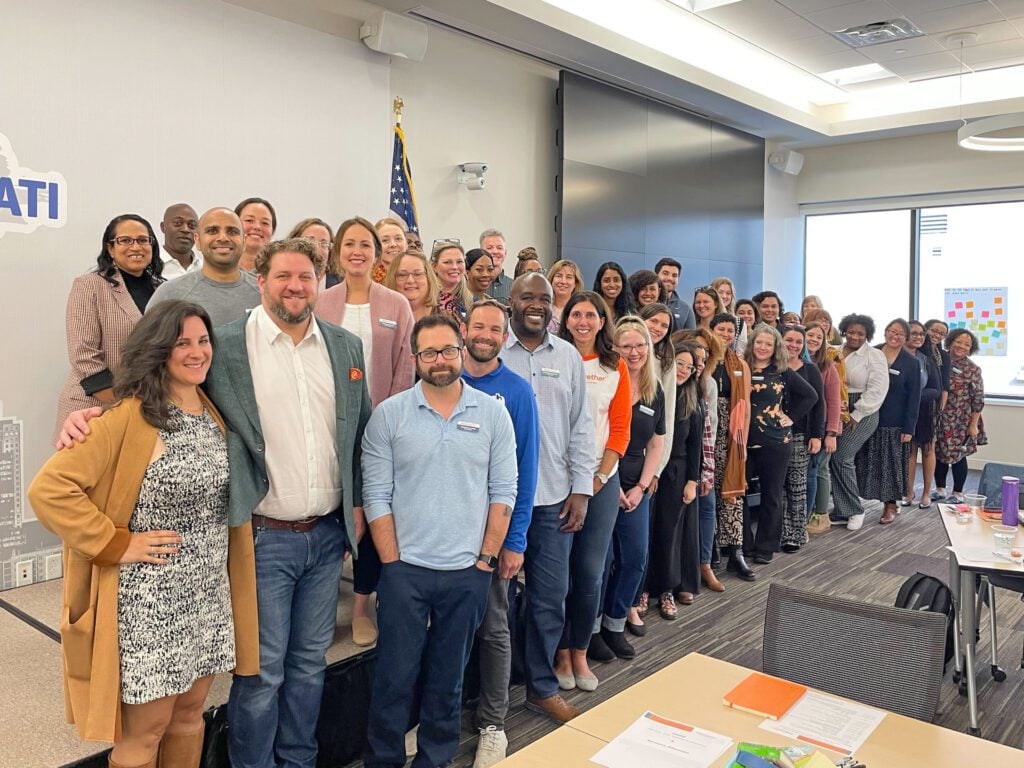After more than 20 years working in the nonprofit sector, the majority of which have been dedicated to the work of StriveTogether and its predecessor organizations, I’m taking a sabbatical this summer.
I never dreamed I’d be in a position to take an extended break from this work. I wasn’t even sure I wanted to step away. There’s so much momentum right now, so much work to be done and ground to make up, especially after the pandemic. This is my life’s work. If it hadn’t been for a trusted colleague and advisor, I never would have considered the opportunity to get some rest and space. I expect to return refreshed, restored and ready to lead as we embark on our bold vision for 2030.
As a runner, I know how important it is to rest. When training for a race, rest days help strengthen your body, sharpen your mind and boost your motivation. Like my fellow runners, most with type-A personalities like me, rest is not in our DNA. We push and overtrain until we’re injured. Twice when training for marathons, I’ve pushed through injury, without enough rest, only to be sidelined on race day. After these heartbreaking experiences, I’ve learned to slow down and listen to my body when it tells me to rest, because I want to be able to run the race and keep running for a long time. 
We often refer to the work we’re doing — work to transform systems to produce more equitable outcomes and put more kids on a path to mobility — as a marathon, not a sprint. Transforming systems that have been in place for hundreds of years is long-term work and we need the stamina to stick with it. Those of us who do this work often see it as a sort of calling. We feel a sense of urgency and push hard to get results. And so often, talented people in this sector burn out.
According to Nonprofit Quarterly, more than 30% of nonprofit workers report feeling burned out, and that percentage is significantly higher for leaders of nonprofit organizations. The Society for Human Resource Management reports that the voluntary turnover rate for nonprofit organizations is 19%, higher than the overall labor market at 12%. For so many of us, the work becomes part of our identity, and that can lead to even higher levels of burnout, especially when achieving significant impact over the long term is often met with setbacks and obstacles along the way.
As I thought more about the possibility of taking this sabbatical, I found myself faced with mixed feelings. On one hand, the prospect of some extended time off sounded glorious. I’ve never even taken more than a week off at one time. I checked email through my maternity leaves — not recommended, but that’s how hard it is for me to disconnect from this work, my life’s work. I started thinking about how much my career — especially this work at StriveTogether — is tied to my identity. Who am I if I’m not here? How will I disconnect? What does it mean to really unplug? And most of all, I thought, “I don’t deserve this. I don’t need rest. I should be working more to take the burden off those working in communities.”
I quickly found through research that nonprofit sabbatical programs are becoming increasingly common. So much so that The Durfee Foundation, which offers grants to organizations to support sabbatical programs, created a guide to developing a policy. I also found that while most sabbatical programs are for C-suite leaders, some organizations are making these policies applicable for all staff, which felt much more in line with StriveTogether’s core values and how I’d want to approach such a policy.

I started talking with my peers in the field about the prospect of a sabbatical. I was surprised by how many leaders I admire and respect had taken sabbaticals. I was equally surprised by how impactful these times away had been for their personal leadership. And I wasn’t at all surprised to hear from these leaders that no one missed them while they were gone — the trains kept on running, their absences barely noticeable. Most described it as quite humbling. It makes sense. Strong organizations should not be so dependent on one person that their absence is detrimental.
I designed the sabbatical policy for StriveTogether to be available to everyone in the organization. As I planned my own time off this summer, I knew I needed to model what this looks like. Not only would my time away from work allow me to rest, reflect, reconnect with family and friends and return refreshed, but it would be a terrific opportunity for other leaders at StriveTogether to step into some of the work that I do. It could unlock innovation, creativity and new possibilities.
I was encouraged to share about my decision by a leader from one of our network communities. During a visit earlier this year, she mentioned her desire to take a sabbatical. The last few years have been especially tough for many of us. After making so much progress improving outcomes, the pandemic had caused setbacks in her partnership’s results. She was navigating staff transitions and leadership transitions in the community. I felt so guilty as I told her about my plans for a sabbatical. I tried to downplay it. And as we talked, she told me how important it is that I take this time off and that I write about it.
This sabbatical is an opportunity to slow down, rest and reconnect to my identity — in fact, I believe it will unlock potential that I haven’t had the space to discover. I plan to travel, spend time with my children, organize and explore new ideas. Writing has long been my primary outlet to process and imagine, so maybe I’ll outline that book I sometimes dream about writing — or maybe not. There are no expectations that I accomplish anything other than coming back to StriveTogether rested and refreshed. And when I return, I know I will be changed and hope the organization will be, as well — for the better. 
I acknowledge this is a luxury and a privilege, and I’m so incredibly fortunate to have this opportunity. I look at this time away as an opportunity to get new perspective, generate innovative ideas and spark renewed enthusiasm for the work I’ve been doing for nearly 20 years. I’ll be leading StriveTogether into its next phase, with a bold new strategic plan starting in 2024. We’re setting ambitious goals to accelerate better and more equitable outcomes, putting more young people on a path to mobility. It’s both exciting and daunting. And it’s a marathon, not a sprint, so I need to be ready to run it on fresh legs.
I’ll be keeping a journal while I’m out and I plan to share the highlights when I return. Remember, in this work, we’re playing the long game. And as in Aesop’s fable “The Tortoise and the Hare,” slow and steady (and well rested) wins the race.






